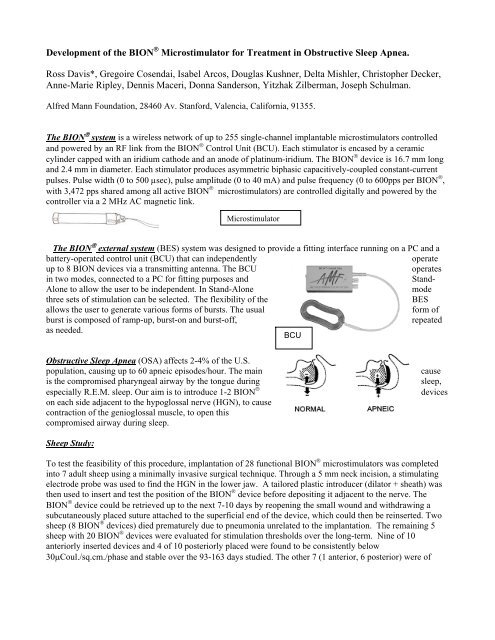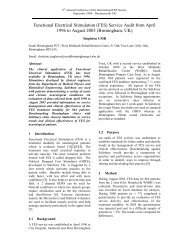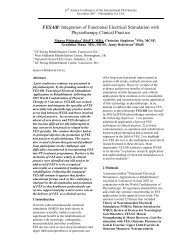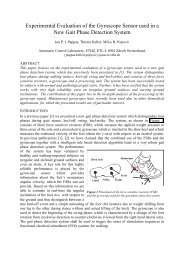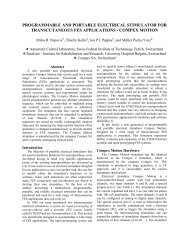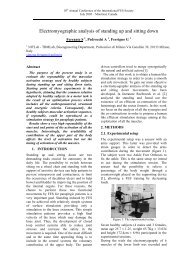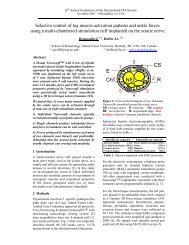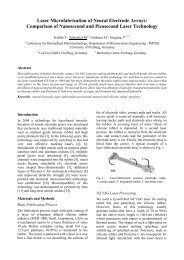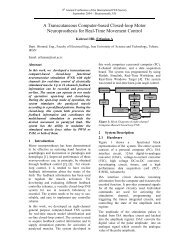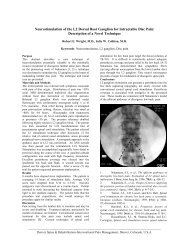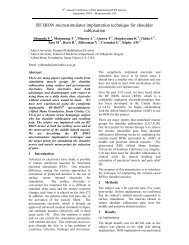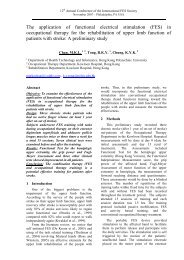Development of the BION Microstimulator for Treatment in ... - IFESS
Development of the BION Microstimulator for Treatment in ... - IFESS
Development of the BION Microstimulator for Treatment in ... - IFESS
You also want an ePaper? Increase the reach of your titles
YUMPU automatically turns print PDFs into web optimized ePapers that Google loves.
<strong>Development</strong> <strong>of</strong> <strong>the</strong> BION ® <strong>Microstimulator</strong> <strong>for</strong> <strong>Treatment</strong> <strong>in</strong> Obstructive Sleep Apnea.<br />
Ross Davis*, Gregoire Cosendai, Isabel Arcos, Douglas Kushner, Delta Mishler, Christopher Decker,<br />
Anne-Marie Ripley, Dennis Maceri, Donna Sanderson, Yitzhak Zilberman, Joseph Schulman.<br />
Alfred Mann Foundation, 28460 Av. Stan<strong>for</strong>d, Valencia, Cali<strong>for</strong>nia, 91355.<br />
The BION ® system is a wireless network <strong>of</strong> up to 255 s<strong>in</strong>gle-channel implantable microstimulators controlled<br />
and powered by an RF l<strong>in</strong>k from <strong>the</strong> BION ® Control Unit (BCU). Each stimulator is encased by a ceramic<br />
cyl<strong>in</strong>der capped with an iridium cathode and an anode <strong>of</strong> plat<strong>in</strong>um-iridium. The BION ® device is 16.7 mm long<br />
and 2.4 mm <strong>in</strong> diameter. Each stimulator produces asymmetric biphasic capacitively-coupled constant-current<br />
pulses. Pulse width (0 to 500 µsec), pulse amplitude (0 to 40 mA) and pulse frequency (0 to 600pps per BION ® ,<br />
with 3,472 pps shared among all active BION ® microstimulators) are controlled digitally and powered by <strong>the</strong><br />
controller via a 2 MHz AC magnetic l<strong>in</strong>k.<br />
<strong>Microstimulator</strong><br />
The BION ® external system (BES) system was designed to provide a fitt<strong>in</strong>g <strong>in</strong>terface runn<strong>in</strong>g on a PC and a<br />
battery-operated control unit (BCU) that can <strong>in</strong>dependently operate<br />
up to 8 BION devices via a transmitt<strong>in</strong>g antenna. The BCU operates<br />
<strong>in</strong> two modes, connected to a PC <strong>for</strong> fitt<strong>in</strong>g purposes and Stand-<br />
Alone to allow <strong>the</strong> user to be <strong>in</strong>dependent. In Stand-Alone mode<br />
three sets <strong>of</strong> stimulation can be selected. The flexibility <strong>of</strong> <strong>the</strong> BES<br />
allows <strong>the</strong> user to generate various <strong>for</strong>ms <strong>of</strong> bursts. The usual <strong>for</strong>m <strong>of</strong><br />
burst is composed <strong>of</strong> ramp-up, burst-on and burst-<strong>of</strong>f, repeated<br />
as needed.<br />
BCU<br />
Obstructive Sleep Apnea (OSA) affects 2-4% <strong>of</strong> <strong>the</strong> U.S.<br />
population, caus<strong>in</strong>g up to 60 apneic episodes/hour. The ma<strong>in</strong> cause<br />
is <strong>the</strong> compromised pharyngeal airway by <strong>the</strong> tongue dur<strong>in</strong>g sleep,<br />
especially R.E.M. sleep. Our aim is to <strong>in</strong>troduce 1-2 BION ®<br />
on each side adjacent to <strong>the</strong> hypoglossal nerve (HGN), to cause<br />
contraction <strong>of</strong> <strong>the</strong> genioglossal muscle, to open this<br />
compromised airway dur<strong>in</strong>g sleep.<br />
Sheep Study:<br />
devices<br />
To test <strong>the</strong> feasibility <strong>of</strong> this procedure, implantation <strong>of</strong> 28 functional BION ® microstimulators was completed<br />
<strong>in</strong>to 7 adult sheep us<strong>in</strong>g a m<strong>in</strong>imally <strong>in</strong>vasive surgical technique. Through a 5 mm neck <strong>in</strong>cision, a stimulat<strong>in</strong>g<br />
electrode probe was used to f<strong>in</strong>d <strong>the</strong> HGN <strong>in</strong> <strong>the</strong> lower jaw. A tailored plastic <strong>in</strong>troducer (dilator + sheath) was<br />
<strong>the</strong>n used to <strong>in</strong>sert and test <strong>the</strong> position <strong>of</strong> <strong>the</strong> BION ® device be<strong>for</strong>e deposit<strong>in</strong>g it adjacent to <strong>the</strong> nerve. The<br />
BION ® device could be retrieved up to <strong>the</strong> next 7-10 days by reopen<strong>in</strong>g <strong>the</strong> small wound and withdraw<strong>in</strong>g a<br />
subcutaneously placed suture attached to <strong>the</strong> superficial end <strong>of</strong> <strong>the</strong> device, which could <strong>the</strong>n be re<strong>in</strong>serted. Two<br />
sheep (8 BION ® devices) died prematurely due to pneumonia unrelated to <strong>the</strong> implantation. The rema<strong>in</strong><strong>in</strong>g 5<br />
sheep with 20 BION ® devices were evaluated <strong>for</strong> stimulation thresholds over <strong>the</strong> long-term. N<strong>in</strong>e <strong>of</strong> 10<br />
anteriorly <strong>in</strong>serted devices and 4 <strong>of</strong> 10 posteriorly placed were found to be consistently below<br />
30µCoul./sq.cm./phase and stable over <strong>the</strong> 93-163 days studied. The o<strong>the</strong>r 7 (1 anterior, 6 posterior) were <strong>of</strong>
higher thresholds and generally had lower stability. Electrode-to-nerve distances <strong>in</strong> 2 sheep (8 implants) showed<br />
a direct correlation to threshold values. The anterior neck approach to <strong>the</strong> HGN provided a closer and thus lower<br />
and more stable stimulation threshold level. Separately, histological evaluation <strong>of</strong> tissues subjected to higher<br />
stimulation showed no chronic tissue damage. Initial histological results revealed an average tissue capsule <strong>of</strong><br />
0.163mm (s.d.= 0.115mm).<br />
mA<br />
mA<br />
10<br />
8<br />
6<br />
4<br />
2<br />
12.0<br />
10.0<br />
8.0<br />
6.0<br />
4.0<br />
2.0<br />
0.0<br />
AR<br />
AL<br />
PR<br />
PL<br />
Thresholds<br />
Sheep # 5, 200 µsec, 20 pps<br />
All BIONs<br />
0 25 50 75 100 125 150 175<br />
Days<br />
BION Distance to Nerve & Threshold<br />
0<br />
0 5 10 15 20 25 30<br />
Distance (mm)<br />
Cadaver Study and Implant Procedure:<br />
Probe <strong>in</strong>sertion Introducer+Probe BION /Hypoglossal Nr.<br />
AR<br />
AL<br />
PR<br />
PL<br />
AR<br />
PR<br />
AL<br />
PL
To fur<strong>the</strong>r evaluate this surgical technique, <strong>in</strong> August 2002, a fresh cadaver with a 49 cm (19½ <strong>in</strong>ch) neck<br />
circumference had <strong>the</strong> left hypoglossal nerve exposed through a 5 cm <strong>in</strong>cision, at a depth <strong>of</strong> 3 cm approximately.<br />
Mov<strong>in</strong>g to a different location, <strong>the</strong> above described <strong>in</strong>sertion technique was used through an anterior midl<strong>in</strong>e<br />
approach at 1 cm above <strong>the</strong> hyoid, angled left at 15 degrees to a depth <strong>of</strong> 4 cm. Upon reopen<strong>in</strong>g <strong>the</strong> <strong>in</strong>itial<br />
<strong>in</strong>cision on <strong>the</strong> left side, <strong>the</strong> cathode <strong>of</strong> <strong>the</strong> BION ® device was found to be ly<strong>in</strong>g adjacent to <strong>the</strong> HGN.<br />
In order to test <strong>the</strong> functionality and reliability <strong>of</strong> <strong>the</strong> BES to control BION ® devices implanted <strong>in</strong> <strong>the</strong> lower jaw,<br />
one BION ® device with attached wires was placed adjacent to <strong>the</strong> hypoglossal nerve and its stimulation output<br />
was monitored. The antenna was placed under <strong>the</strong> ch<strong>in</strong> us<strong>in</strong>g a garment specifically designed <strong>for</strong> <strong>the</strong> sleep apnea<br />
application that holds <strong>the</strong> antenna <strong>in</strong> <strong>the</strong> optimal anatomical position <strong>for</strong> driv<strong>in</strong>g BION ® devices.<br />
System Test<strong>in</strong>g:<br />
The results on <strong>the</strong> cadaver test showed that <strong>the</strong> BION ® External System was capable <strong>of</strong> deliver<strong>in</strong>g enough power<br />
to BION ® devices <strong>in</strong>serted adjacent to <strong>the</strong> hypoglossal nerve. The BION ® device was capable <strong>of</strong> reach<strong>in</strong>g<br />
stimulation parameters as high as 10 mA, 200 us, 20 pps, which was reliable, even under antenna displacements<br />
<strong>of</strong> up to 4 cm contra-laterally to <strong>the</strong> anterior BION ® implantation site.<br />
Based on <strong>the</strong> above <strong>in</strong>-vivo and cadaver studies and based on additional <strong>in</strong>-vitro qualification studies, we are<br />
submitt<strong>in</strong>g an FDA IDE <strong>for</strong> <strong>the</strong> treatment <strong>of</strong> obstructive sleep apnea by us<strong>in</strong>g <strong>the</strong> BION ® system; this is <strong>in</strong><br />
conjunction with one <strong>of</strong> <strong>the</strong> primary U.S. sleep disorders research centers.<br />
[BION ® is a registered trademark <strong>of</strong> Advanced Bionics Corporation, Valencia, CA.]<br />
Acknowledgements to P. Mobley, K. Fey, D. Canfield, C. Byers, C. Tanacs, M. Vogel, M. Chamberla<strong>in</strong>, D.<br />
Richards, N. Embrey and J. Adomian <strong>for</strong> <strong>the</strong>ir considerable contributions.


